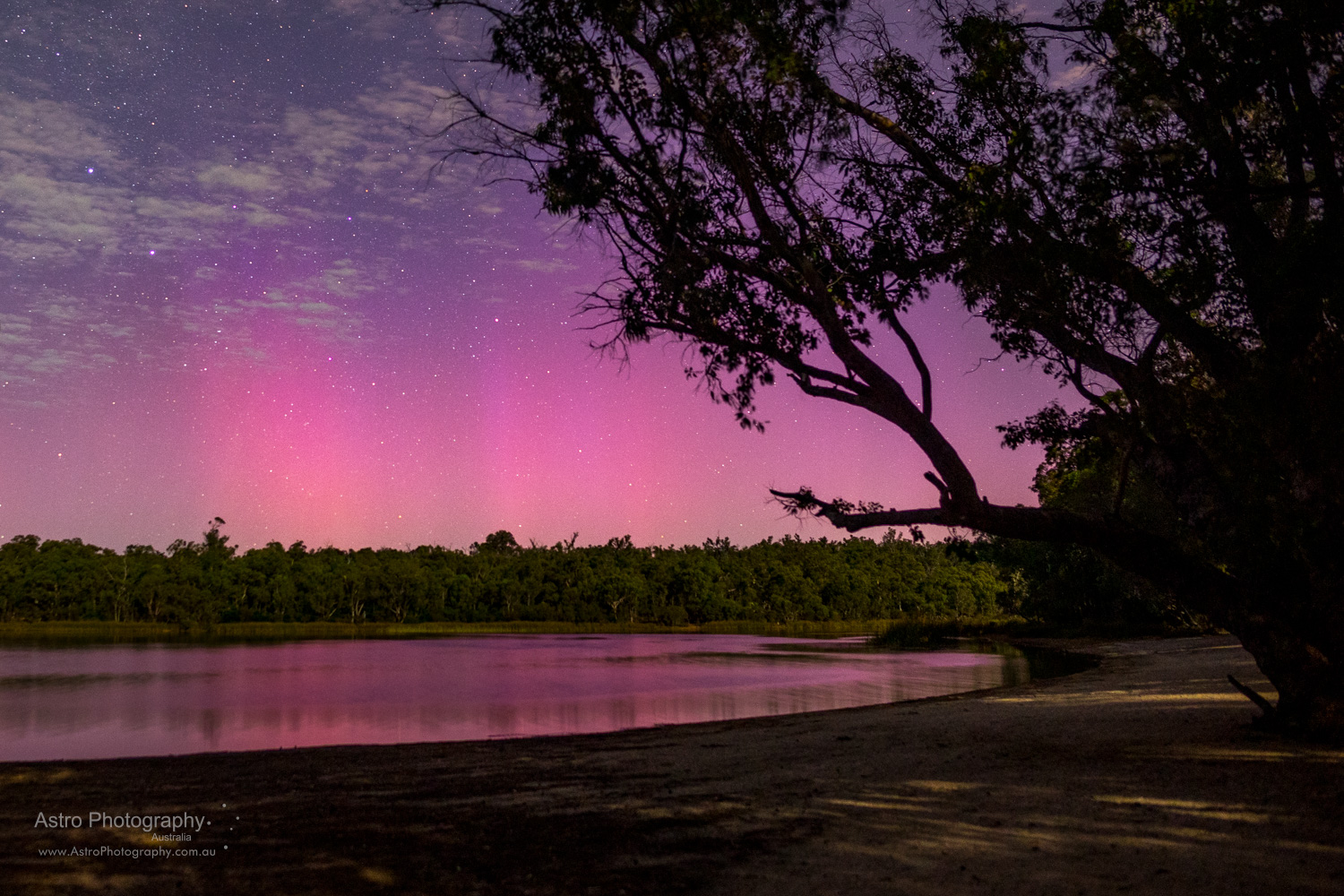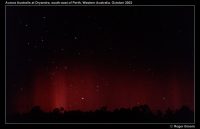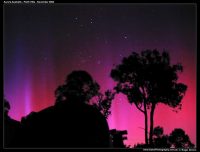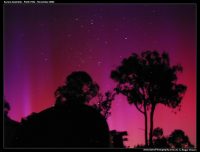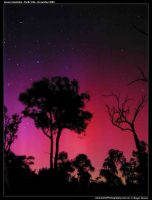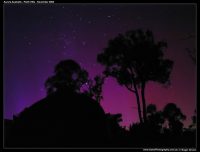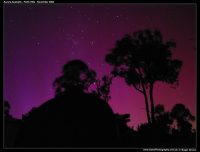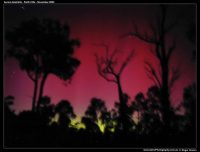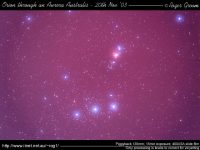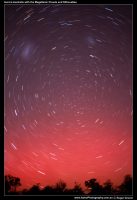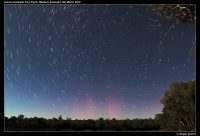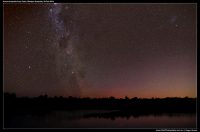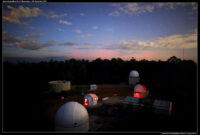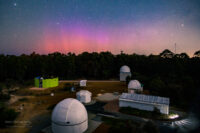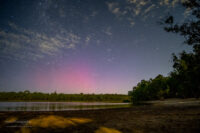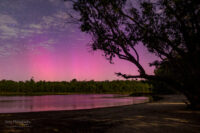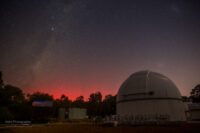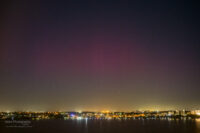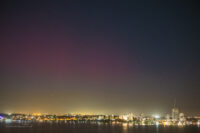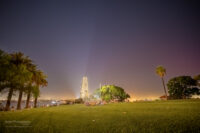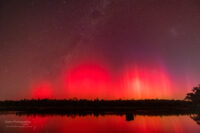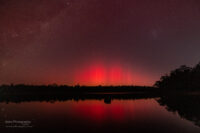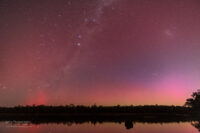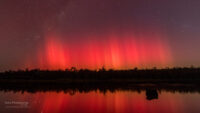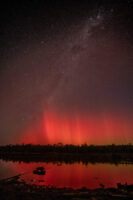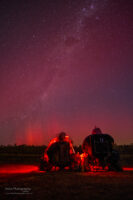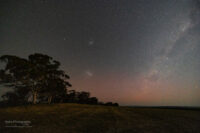It is not often Aurora Australis are visible from as far north as a place like Western Australia, but it does occasionally happen.
To learn how to photograph Aurora Australis, participate in one of my astrophotography workshops or book a one-on-one workshop to prepare for your upcoming aurora travel/photography plans.
Past Aurora Australis from Western Australia
I have captured photographs of Aurora Australis from the hills of Perth (Bickley and Chidlow), and Dryandra near Narrogin in the state’s south-east. Each time I have been surprised by how bright the Aurora have been considering the estimates and latitude of Perth. The following dates is my record of Aurora in Western Australia:
- October 2003 – Bright pink aurora visible from Wheatbelt WA (Narrogin), would have been visible to Perth latitudes. Photographed using film SP1000 camera.
- November 2003 – Bright green and pink Aurora visible from Perth Hills, extending so far north that the constellation of Orion was washed out with pink. This means the Aurora was extending overhead. Photographed using digital Olympus 2020Z camera and film SP1000 camera.
- 9th March 2012 – Bright aurora visible from Perth Hills but washed out by the full moon. Could have been equal to 2003 if not for the full moon. Photographed with Canon DSLR.
- 20th February 2014 – Faint red aurora visible on the southern horizon from Perth Hills.
- 18th March 2015 – Aurora visible from Perth Hills but I missed it 🙁 Display seems to have been similar to 9th March 2012 or October 2003 but at New Moon this time.
- 22nd – 23rd June 2015 – Aurora visible from throughout southern Western Australia including the Perth metro and hills areas. Photographs show green near the horizon and pink above.
- 6th September 2017 – Aurora Australis photographed from Perth Observatory during a night sky tour. Photographed with Canon DSLR.
- 4th November 2021 – Aurora Australis photographed from Perth Observatory during a night sky tour. Photographed with Canon DSLR.
- 22nd October 2022 – Aurora photographically captured in the Central Wheatbelt while facilitating a nightscapes workshop for Astro Photography Australia
- 21st February 2023 – Aurora photographed from the south-west, very close to evening twilight and ending shortly after.
- 27th February 2023 – Aurora photographed from all over the south-west of Western Australia including further north than Perth.
- 23rd March 2023 – Aurora Australis photographed form Perth Observatory.
- 5th November 2023 – Widespread brilliant displays of Aurora Australis, which unfortunately I missed most of, only capturing a few shots at Lake Leschenaultia before cloud.
- 1st December 2023 – Widespread high level of activity. Many brilliant displays from around WA. I photographed the aurora from the Perth CBD looking over South Perth, and from Kings park.
- 11th May 2024 – Widespread high level of activity. I photographed the bright displays of naked eye visible beams from Lake Leschenaultia.
- 28th June 2024 – High level of activity though not as pronounced or viewed as the 11th May aurora. The aurora was more condensed and concentrated to southern beams.
- 7th October 2024 – Low level of activity after sunset, fading by 9pm.
- 11th October 2024 – Very high level of activity in the early hours of the morning with widespread high level of activity approx 2:30am and 4am but sustained throughout.
Forecasting An Aurora
Primarily I would refer you to applications, sites, and forums for up to date forecast experts have made rather than deducing your own forecast. Resources include:
- Aurora Australis Western Australia group on Facebook
- https://www.sws.bom.gov.au/ BOM Space Weather
- https://www.swpc.noaa.gov/ NOAA Space Weather Prediction Centre
- SpaceWeather.com
- Space Weather Live app (iOS/Android)
- Aurora Fcst app (see iOS/Android app stores)
- Aurora (see iOS/Android app stores)
Forecasting metrics to consider:
- Solar Wind Data: Monitor solar wind parameters like speed, density, and magnetic field strength. Higher solar wind speeds and disturbances indicate an increased likelihood of auroral activity.
- KP Index: This scale measures geomagnetic activity on a scale of 0 to 9. KP values above 4 suggest a higher chance of visible auroras, especially in higher latitudes.
- BZ: This must be negative (-ve).
For Perth, I have seen aurora at Kp5+ however it depends on other factors as mentioned above. Kp is no longer considered the golden metric to follow for southern hemisphere. I am not a forecasting expert so suggest you consult resources above regarding forecasting.
Where to View an Aurora Australis in Western Australia
TLDR: Anywhere with a southern aspect, and as far south as practical, and as far from light pollution as practical.
The best place to view Aurora Australis from Australia is south, as far south as you can go with clear skies. In Western Australia this means places like Albany or the south-west Capes region, if the weather is clear. Aurora are sometimes visible from as high as Perth and even higher as my photographs below illustrate, but it depends entirely on the circumstances at the time, and involves an element of luck. If you live in Perth and are keen to see Aurora, and know the coming night might be good, driving or flying south or south-east is your best best. Aim for dark skies (country location away from city) as far south or south-east as you are happy to drive. I say south-east because in WA the light pollution (and population) tend to hug the west coast.
Photographing Aurora Australis from Western Australia
See my page: Photographing Aurora Australis in Western Australia
To photograph aurora you will ideally have a tripod and reasonably sensitive camera (any modern DSLR or Mirrorless camera would do). Use a long shutter speed of several seconds or more (try 10-15 seconds), and a high ISO (800ISO or higher). Use a moderate wide field of view (such as between 24mm and 14mm) and use a fast aperture (eg f/1.2, F/1.4, f/1.8, f/2.8). A cable release/interval timer is useful to minimise camera shake and facilitate sequences of multiple exposures. Be mindful of the lens fogging up due to dew/moisture. Experiment with exposure times and ISO.
Visually Seeing Aurora Australis
To view Aurora you will be looking for pillars of light coming from the southern horizon. Some times when I have seen the Aurora in the hills of Perth I have initially mistaken them for the spotlight of kangaroo shooters in the bush, looking like a spotlight beam extending up from the southern horizon. It is only when a photograph is taken that the colour usually shows. Bright aurora australis do have faint visual colour but it is subtle at high latitudes like Perth. In Perth I have seen pillars of light extending from the southern horizon overhead to about 20 degrees north of the zenith as evident by my photograph of Orion with Aurora Australis below.
To see when I get new aurora photographs and keep up with when I post an alert, I suggest you follow my page: https://www.facebook.com/astrophotographyaustralia and I will post pictures at Astro Photography Australia where I sell photographs of aurora and other astrophotography.
